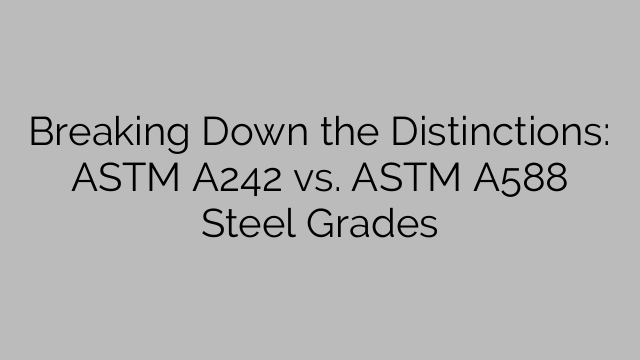ASTM A242 and ASTM A588 are both steel grades commonly used in construction and building applications. While they may seem similar at first glance, there are distinct differences between the two that are important to understand when choosing the appropriate material for a particular project.
ASTM A242 steel grade is a high-strength low-alloy structural steel that is primarily used in structural applications such as buildings and bridges. This steel has a yield strength of 50,000 pounds per square inch (psi) and an ultimate tensile strength of 70,000 psi. It contains copper, chromium, and nickel as alloying elements, which provide enhanced atmospheric corrosion resistance. ASTM A242 steel has a weathering ability that allows it to form a protective oxide layer when exposed to the elements, thereby significantly reducing corrosion.
On the other hand, ASTM A588 steel grade is a high-strength low-alloy structural steel that is mainly used in structural applications such as bridges and buildings. It has a yield strength of 50,000 psi and an ultimate tensile strength of 70,000 psi, similar to ASTM A242. However, what sets ASTM A588 apart is its ability to withstand harsh weather conditions. This steel grade contains copper, chromium, and nickel, which promote the formation of a protective patina when exposed to the atmosphere. This patina acts as a shield against corrosion and is particularly beneficial in coastal or high-humidity environments.
When it comes to weldability, both ASTM A242 and ASTM A588 can be easily welded using common welding techniques such as SMAW (shielded metal arc welding) and GTAW (gas tungsten arc welding). However, it is important to note that slight differences may exist in the welding procedures and consumables required for each steel grade. It is recommended to consult the appropriate welding standards and guidelines to ensure proper welding practices are followed.
In terms of appearance, ASTM A242 and ASTM A588 steel grades have slightly different aesthetics. ASTM A242 develops a smoother, more uniform patina over time, while ASTM A588 tends to have a more textured and rugged appearance. The choice between the two may ultimately depend on the desired visual effect and the specific project requirements.
When selecting between ASTM A242 and ASTM A588 steel grades, it is crucial to consider the environmental conditions the structure will be exposed to. If the project is situated in an area known for severe weather conditions, frequent exposure to water, or high humidity, ASTM A588 may be the better choice due to its enhanced corrosion resistance properties. However, if the project does not involve exposure to such conditions, ASTM A242 may be a suitable and cost-effective alternative.
In conclusion, the key differences between ASTM A242 and ASTM A588 are their corrosion resistance capabilities and appearance. ASTM A242 offers excellent atmospheric corrosion resistance and develops a smoother patina over time, while ASTM A588 provides superior resistance to harsh weather conditions and has a more textured appearance. Understanding these distinctions is vital in selecting the most appropriate steel grade for a specific project, ensuring durability, maintainability, and long-term performance.

